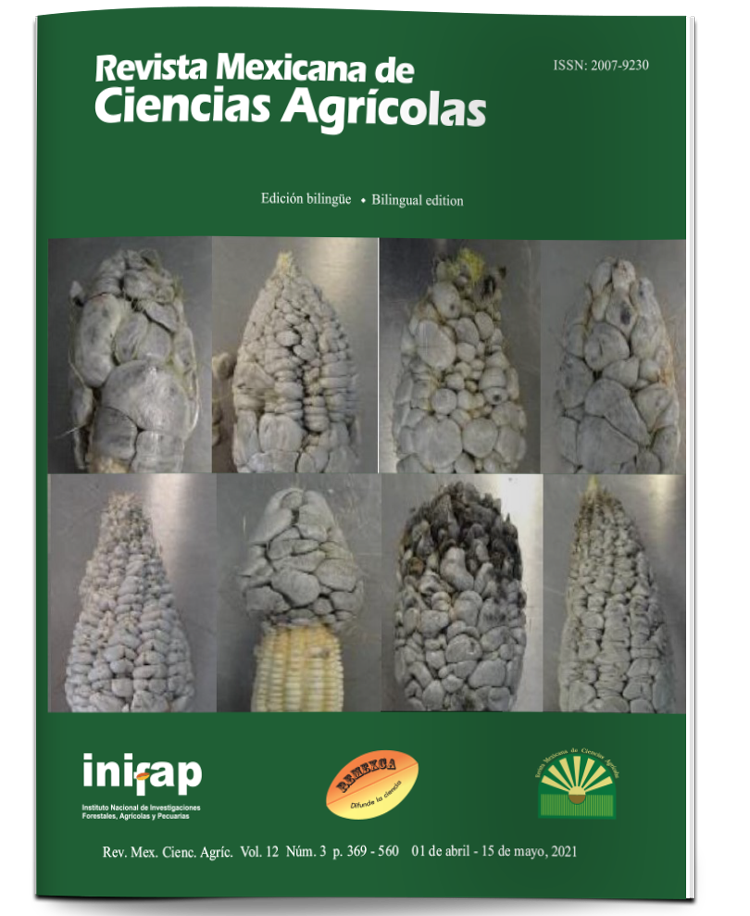Phytophthora species associated with irrigation water in the Culiacán Valley
DOI:
https://doi.org/10.29312/remexca.v12i3.2619Keywords:
nucleic acids, oomycetes, pseudo-fungus, vegetablesAbstract
In Mexico there are few studies describing aquatic bodies used for agriculture and the role of irrigation water as a source of inoculum, persistence and dispersal of phytopathogenic parasites, such as oomycetes that inhabit aquatic environments with the capacity to infect a wide range of cultivated hosts. Due to the lack of information on which oomycetes genus and species are present in the water, their identification is of paramount importance in managing alternative management and control of them for agricultural production in the region. In order to determine which oomycetes are isolated in surface waters used for irrigation in the Culiacán Valley, Sinaloa, in the period from September 2018 to January 2019, in different agricultural water networks (reservoir, ponds, rivers and canals), floating traps made with polypropylene bags and two pear fruits that were placed that served as bait. Oomycete isolates were obtained, which were identified based on their morphological characteristics and DNA sequences (with ITS 4/6, COX and NADH initiators), pathogenicity tests were also performed on plants and fruits of the solanacea and cucurbitaceae families. The organisms were isolated and identified: Phytophthora parsiana, P. virginiana, P. lagoariana, P. capsici and P. hydropathica. All Phytophthora species were pathogenic, they had the ability to infect plants and fruits, causing symptoms of wilting and rotting in the inoculated vegetables.
Downloads
Downloads
Published
How to Cite
Issue
Section
License
The authors who publish in Revista Mexicana de Ciencias Agrícolas accept the following conditions:
In accordance with copyright laws, Revista Mexicana de Ciencias Agrícolas recognizes and respects the authors’ moral right and ownership of property rights which will be transferred to the journal for dissemination in open access. Invariably, all the authors have to sign a letter of transfer of property rights and of originality of the article to Instituto Nacional de Investigaciones Forestales, Agrícolas y Pecuarias (INIFAP) [National Institute of Forestry, Agricultural and Livestock Research]. The author(s) must pay a fee for the reception of articles before proceeding to editorial review.
All the texts published by Revista Mexicana de Ciencias Agrícolas —with no exception— are distributed under a Creative Commons License Attribution-NonCommercial 4.0 International (CC BY-NC 4.0), which allows third parties to use the publication as long as the work’s authorship and its first publication in this journal are mentioned.
The author(s) can enter into independent and additional contractual agreements for the nonexclusive distribution of the version of the article published in Revista Mexicana de Ciencias Agrícolas (for example include it into an institutional repository or publish it in a book) as long as it is clearly and explicitly indicated that the work was published for the first time in Revista Mexicana de Ciencias Agrícolas.
For all the above, the authors shall send the Letter-transfer of Property Rights for the first publication duly filled in and signed by the author(s). This form must be sent as a PDF file to: revista_atm@yahoo.com.mx; cienciasagricola@inifap.gob.mx; remexca2017@gmail.
This work is licensed under a Creative Commons Attribution-Noncommercial 4.0 International license.



